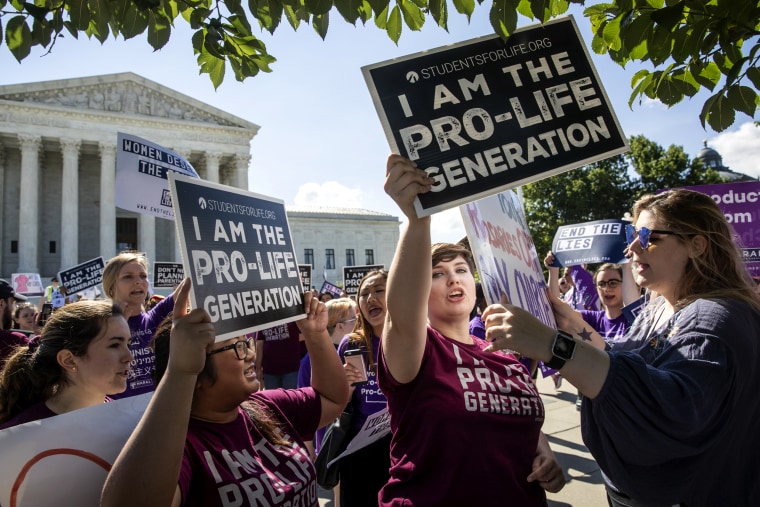From the moment that Brett Kavanaugh was sworn in as the newest associate justice of the U.S. Supreme Court, abortion opponents have been eagerly anticipating the day that the newly minted far-right conservative bench would weigh in on one of the many abortion rights cases primed for review.
On Tuesday, they got their wish — but much like the Trump presidency itself, the Supreme Court decision on Indiana’s series of abortion laws offered some red meat to the base, but failed to fulfill their wildest dreams.
The court’s ruling came in response to Box v. Planned Parenthood, a challenge to a broad 2016 omnibus anti-abortion bill signed into Indiana law by then-Gov. Mike Pence.
Among the myriad new rules, only two specific provisions were before the Supreme Court. One would have made it a crime to provide an abortion if it was allegedly being done because of the race, gender, nationality or a potential diagnosis of permanent disability (like Down syndrome); the second mandated that all miscarried or aborted fetuses or embryos must be buried or cremated, rather than disposed of through traditional means used for any other biological remains.
In a somewhat surprising move, the court chose not to take up the so-called “discrimination” ban, but did reverse the lower court’s ruling, allowing Indiana to require mandatory burial or cremation.
Anti-abortion activists claim the burial provision is necessary to provide “dignity” to embryos and fetuses, ensuring they “receive a respectful disposition after death,” whether the person who was carrying that pregnancy wants it or not.
But “burial” bills actually serve a two-fold purpose for abortion opponents. First, such provisions allow them to make their case that there is no difference between an embryo or a toddler — other than the fact that one is inside another human being and the other is not. After all, if every result of a failed or terminated pregnancy is interred or cremated just like a human body is, clearly that delineates even a pea-sized cluster of cells from medical waste.
Second, burial bills add yet another pressure point in the movement's efforts to strip away a clinic’s ability to legally perform an abortion procedure. Similar to legislation requiring that abortion providers have hospital admitting privileges , which allowed activists to harass hospitals out of working with abortion providers , bills specifying burial or cremation after an abortion can offer the same opportunity to throttle abortion access by approaching the cremation and burial facilities whose services would now be required by patients and abortion providers.
But more than that, taking away the ability for people to decide for themselves how they wish to proceed when it comes to dealing with the remains from a pregnancy — including those who have miscarried their wanted pregnancies— was an unusually callous move. Similar legislation was rejected by other states, including South Carolina and Mississippi. As someone who experienced my own miscarriage of a very wanted pregnancy at 12 weeks gestation, I know that being told that I must approve either a burial or cremation for the remains of that loss would only have made an agonizing process even more harrowing for both me and my husband.
Aggravatingly, though, the probable impetus for the bill came from the anti-abortion movement’s continuing campaign to convince people that Planned Parenthood Federation of America was involved in an illegal fetal tissue trafficking scheme, profiting from selling “baby parts” retrieved from patient procedures. (This was proven false over and over again). Anti-abortion activists like David Daleiden — the man at the center of the false claims of fetal tissue trafficking — pushed for additional burdens on how to dispose of fetal remains as a potential way to shut down or limit clinics. “Laws requiring that human fetuses receive death certificates — that creates a huge bottleneck for them. That makes it difficult for the clinics to work," he explained to a reporter at a 2015 convention of the conservative American Legislative Exchange Council. Americans United for Life created model legislation around the topic, just to double-down on the manufactured controversy.
And, while there is little doubt that the burial requirement will make things harder for abortion providers and patients, it’s hard to imagine that such an incremental victory wasn’t overshadowed by the court’s refusal to take up the discrimination provisions, which could have offered the bench a chance to revisit Roe v. Wade itself. That response likely has even the most stalwart anti-abortion activists wondering if maybe that fifth vote to end Roe isn’t really on the bench yet.
Still, it’s entirely possible that the conservative wing of the court is staying silent for now because of bad timing. After all, any verdict that puts the legality of abortion into the hands of individual states is likely to energize Democrats — and potentially lose Republicans leverage with those single issue voters who show up to the polls when they believe that banning abortion is on the line, as it was with Trump in 2016. With the 2020 elections only 18 months away, any case on the docket now that could overturn Roe would be ruled on before election day — and, unlike past courts, several current justices have more political leanings and conservative movement experience.
Whatever the reason, though, the conservative wing of the court is acting much like the president himself — eager to engage on hot topics in ways that have minimal practical impact, and failing to follow through on the big expectations they have engendered in vociferous activists.




